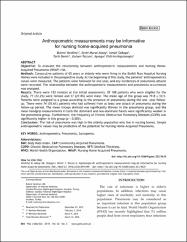| dc.contributor.author | Yardımcı, Bülent | |
| dc.contributor.author | Aksoy, Şevki Murat | |
| dc.contributor.author | Özkaya, İsmail | |
| dc.contributor.author | Demir, Tarık | |
| dc.contributor.author | Tezcan, Gülşen | |
| dc.contributor.author | Kaptanoğlu, Ayşegül Yıldırım | |
| dc.date.accessioned | 2021-12-12T17:00:40Z | |
| dc.date.available | 2021-12-12T17:00:40Z | |
| dc.date.issued | 2016 | |
| dc.identifier.issn | 1682-024X | |
| dc.identifier.uri | https://doi.org/10.12669/pjms.323.9635 | |
| dc.identifier.uri | https://hdl.handle.net/20.500.11857/2814 | |
| dc.description.abstract | Objective: To evaluate the relationship between anthropometric measurements and Nursing Home-Acquired Pneumonia (NHAP) risk. Methods: Consecutive patients of 65 years or elderly who were living in the Balikli Rum Hospital Nursing Homes were included in this prospective study. At the beginning of this study, the patients' anthropometrics values were measured. The patients were followed for one year, and any incidences of pneumonia attacks were recorded. The relationship between the anthropometric measurements and pneumonia occurrences was analyzed. Results: There were 133 inmates at the initial assessments. Of 108 patients who were eligible for the study, 77 (72.2%) were female and 37 (27.8%) were male. The mean age of the group was 79.8 +/- 10.5. Patients were assigned to a group according to the presence of pneumonia during the one -year followup. There were 74 (55.6%) patients who had suffered from at least one attack of pneumonia during the follow-up period. The mean triceps skinfold was significantly thinner in the pneumonia group, and the mean handgrip measurements in both the dominant and non-dominant hands were significantly weaker in the pneumonia group. Furthermore, the frequency of Chronic Obstructive Pulmonary Diseases (COPD) was significantly higher in this group (p < 0.001). Conclusions: The risk of pneumonia was high in the elderly population who live in nursing homes. Simple anthropometric values may be predictive of the potential for Nursing Home-Acquired Pneumonia. | en_US |
| dc.language.iso | eng | en_US |
| dc.publisher | Professional Medical Publications | en_US |
| dc.relation.ispartof | Pakistan Journal of Medical Sciences | en_US |
| dc.identifier.doi | 10.12669/pjms.323.9635 | |
| dc.rights | info:eu-repo/semantics/openAccess | en_US |
| dc.subject | Anthropometry | en_US |
| dc.subject | Pneumonia | en_US |
| dc.subject | Sarcopenia | en_US |
| dc.title | Anthropometric measurements may be informative for nursing home-acquired pneumonia | en_US |
| dc.type | article | |
| dc.department | Fakülteler, Sağlık Bilimleri Fakültesi, Beslenme ve Diyetetik Bölümü | |
| dc.identifier.volume | 32 | en_US |
| dc.identifier.startpage | 694 | en_US |
| dc.identifier.issue | 3 | en_US |
| dc.identifier.endpage | 699 | en_US |
| dc.relation.publicationcategory | Makale - Uluslararası Hakemli Dergi - Kurum Öğretim Elemanı | en_US |
| dc.authorscopusid | 56565405000 | |
| dc.authorscopusid | 56204363100 | |
| dc.authorscopusid | 57189332535 | |
| dc.authorscopusid | 57198319349 | |
| dc.authorscopusid | 57189703436 | |
| dc.authorscopusid | 55830401400 | |
| dc.identifier.wos | WOS:000377706400035 | en_US |
| dc.identifier.scopus | 2-s2.0-84974660146 | en_US |
| dc.identifier.pmid | PubMed: 27375716 | en_US |



















